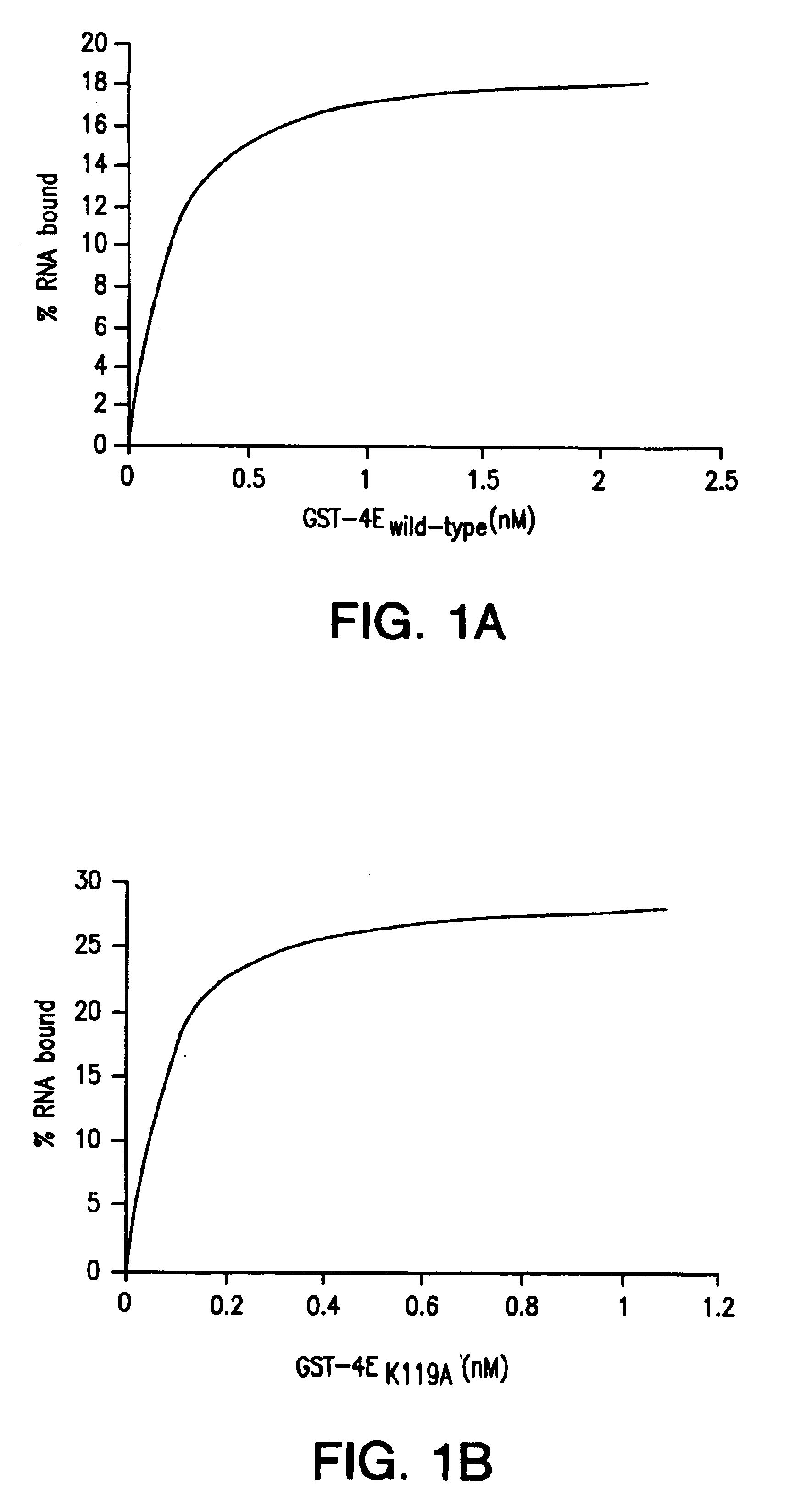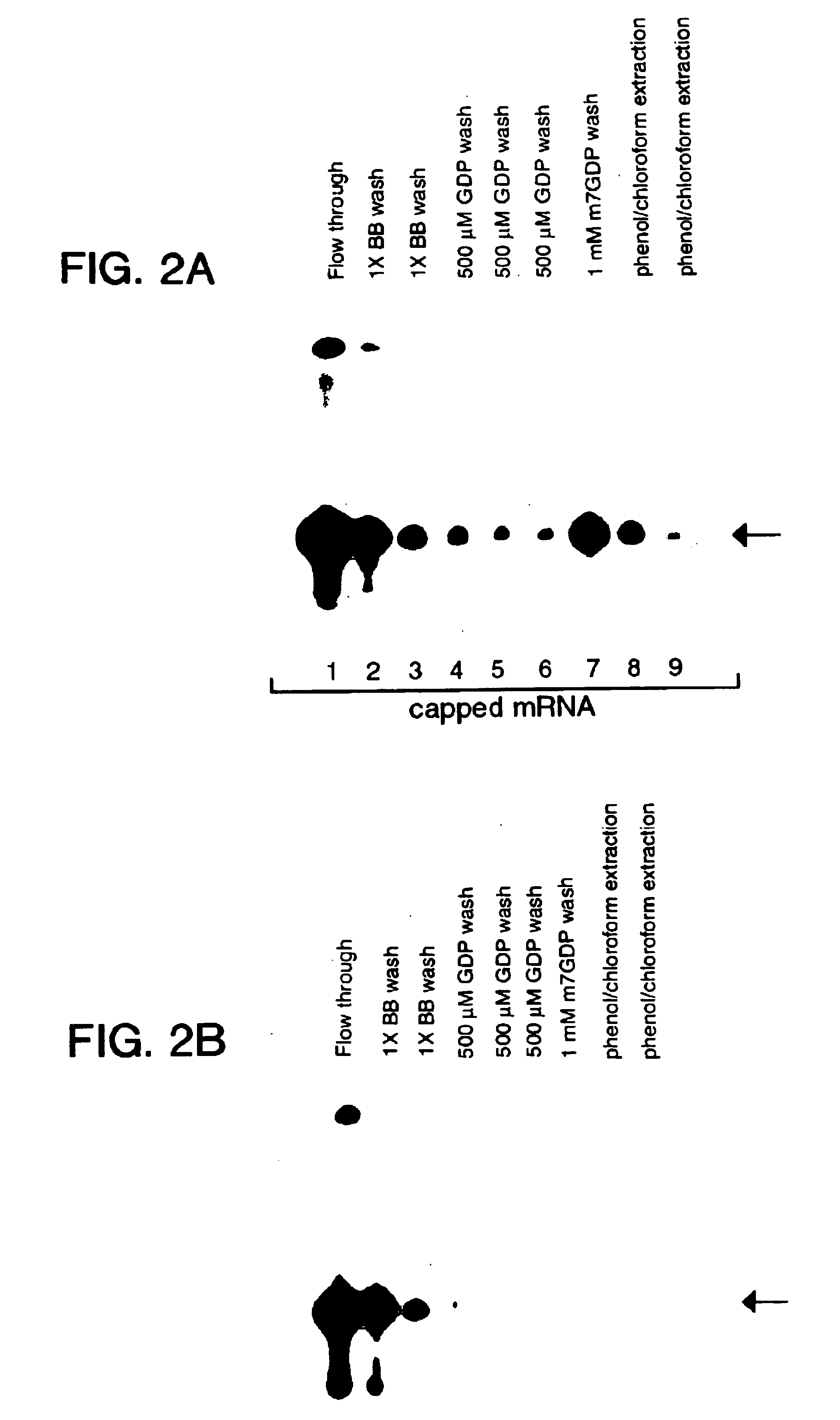Preparation of capped mRNA
a technology of capped mrna and messenger rna, which is applied in the field of capped mrna preparation, can solve the problems of low yield, difficult to obtain, and to be faced, and achieve the effect of adjusting the expression level of gen
- Summary
- Abstract
- Description
- Claims
- Application Information
AI Technical Summary
Benefits of technology
Problems solved by technology
Method used
Image
Examples
example 1
[0037]Rapid Isolation of mRNA by Batch Binding with GST-4E.
[0038]Glutathione agarose beads (Sigma, St. Louis, Mo.) were hydrated with diethyl pyrocarbonate (DEPC)-treated water for 2 hr at room temperature. The beads (1 ml, packed volume) were mixed with FPLC purified GST-4E protein (2.8 mg) in PBS buffer for 1 hr at 4° C. for 10 min) were mixed and added 200 μl of 1X mRNA binding buffer (BB) (10 mM KHPO4 [pH 8.0], 100 mM KC1, 2 mM EDTA, 5% glycerol, 100 μg / ml bovine liver tRNA (Sigma, St. Louis, Mo.), 6 mM dithiothreitol, 1.3% polyvinyl alcohol (Sigma, St. Louis, Mo.), 0.005% TritonX-100, 20 U RNasin [Roche, Basel, Switzerland]). The incubation was performed for 1 hr in a 1.5 nonstick hydrophobic microfuge tube (Gene Mate). Following end-over-end mixing at room temperature, the resin was washed twice with 1 ml of 1X binding buffer and three times with 1 ml of 1X binding buffer containing either 500 1 μM GDP. mRNA was specifically eluted with 1 ml or less 1X binding buffer containin...
example 2
[0041]Specificity of GST-4EK119A for 5′ Capped mRNA.
[0042]The rapid batch purification of mRNA using GST-4EK119A was tested for its ability to bind both 5′ capped and uncapped mRNAs. Both 5′ capped and uncapped mRNAs synthesized in vitro using T7 polymerase were mixed with GST-4EK119A agarose beads, washed with 1X binding buffer, and 500 μM GDP and eluted with 1 mM m7GDP as described in Example 1. mRNA that remained bound to GST-4E despite the m7GDP elution step was recovered by extraction with acid phenol / chloroform. mRNA present in different purification stages using GST-4EK119A agarose beads are shown for 5′ capped (FIG. 2A) and uncapped mRNA (FIG. 2B). mRNA present in each sample was precipitated with ethanol and analyzed by 8 M urea-polyacrylamide (6%) gel electrophoresis. The arrow indicates the size of full-length mRNA (50 nt) used as a starting material.
example 3
[0043]The Purification of Native Functional mRNA from Total Human Liver RNA Using GST-4EK119A in a Batch Method and Oligo(dT) in a Column Method.
[0044]Five hundred (500) μg of total RNA from normal or HCV-infected liver was mixed with either GST-4EK119A or applied to an oligo(dC10T30) column. Agarose beads linked to GST-4EK119A (200 μl packed volume) were incubated with total RNA in 500 μl 1X binding buffer for 1 hr at room temperature. The beads were washed twice with 1 ml 1X binding buffer and three times with 1X binding buffer containing 500 μM GDP as described in Example 1. mRNA was recovered by directly extracting beads with acid phenol / chloroform. The mRNA recovered was precipitated in the presence of glycogen and ethanol. Poly(A)-tailed mRNA was purified as suggested by the manufacturer using oligotex (QIAGEN™, Valencia, Calif.).30% of the mRNA recovered from each sample using either GST-4EK119A or oligo(dT) was analyzed by 1% formaldehyde agarose gel electrophoresis. FIG. 3A...
PUM
| Property | Measurement | Unit |
|---|---|---|
| Affinity | aaaaa | aaaaa |
Abstract
Description
Claims
Application Information
 Login to View More
Login to View More - R&D
- Intellectual Property
- Life Sciences
- Materials
- Tech Scout
- Unparalleled Data Quality
- Higher Quality Content
- 60% Fewer Hallucinations
Browse by: Latest US Patents, China's latest patents, Technical Efficacy Thesaurus, Application Domain, Technology Topic, Popular Technical Reports.
© 2025 PatSnap. All rights reserved.Legal|Privacy policy|Modern Slavery Act Transparency Statement|Sitemap|About US| Contact US: help@patsnap.com



